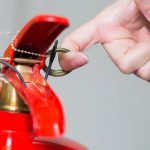Fire Safety Equipment Maintenance: A Checklist for Homeowners and Businesses
February 9, 2024 5:54 pm Leave your thoughts
1. Fire Extinguishers:
Fire extinguishers are your first line of defense in combating small fires. Conduct a monthly check to ensure that they are easily accessible, unobstructed, and have the correct pressure indicated on the pressure gauge. Inspect the extinguisher’s seals, nozzles, and hoses for any signs of damage. Additionally, ensure that the classes of fire extinguishers you have are suitable for the types of fires that could occur in your home or workplace.
2. Fire Alarm Systems:
Fire alarm systems play a crucial role in alerting occupants to a potential fire, providing ample time for evacuation. Monthly testing of fire alarm systems is vital to ensure they are operational. Test all alarm components, including smoke detectors, heat detectors, manual pull stations, and any other devices installed. Regularly replace batteries in battery-operated smoke detectors and replace faulty or expired batteries promptly.
3. Emergency Lighting:
In a fire emergency, visibility is limited due to smoke and power outages. Emergency lighting systems serve as a guide for safe evacuation. Regularly test emergency lighting to ensure it illuminates properly during power failures. Test the backup batteries, light bulbs, and switches. Replace any faulty or dim lights promptly to maintain safe evacuation routes.
4. Sprinkler Systems:
Sprinkler systems are essential for controlling and suppressing fires automatically. Inspect the sprinkler heads to ensure they are free from damage or obstruction. Make sure the control valves are in the open position. Regularly test the system according to the manufacturer’s guidelines, and promptly repair any malfunctions.
5. Fire Suppression Systems:
Certain environments, such as commercial kitchens, require specialized fire suppression systems, such as kitchen hood suppression systems. These systems extinguish fires at their source, preventing them from spreading. Follow the manufacturer’s instructions for regular inspections and servicing, including checking the pressure gauges, ensuring proper chemical levels, and conducting functional tests.
6. Fire Hoses and Cabinets:
Fire hoses and cabinets are vital for containing and extinguishing fires before they escalate. Inspect fire hoses regularly for any damages such as cuts, leaks, or cracks. Ensure that they are properly stored in cabinets with clear access and are not blocked by any objects. Verify that the cabinets are in good condition and labeled correctly.
7. Exit Routes:
Well-maintained and clearly marked exit routes are essential for swift and safe evacuations during a fire emergency. Regularly inspect exit signs for visibility and functionality. Ensure that exit doors are not obstructed, can be opened easily, and close securely. Test panic bars and emergency exit devices to ensure they are in proper working condition.
8. Fire Escape Plans:
Developing and regularly reviewing fire escape plans with all occupants is crucial for their safety. Periodically revisit the escape routes, meeting points, and emergency contacts to keep everyone informed and prepared. Regularly conduct fire drills to ensure that everyone understands the procedures and can evacuate swiftly.
9. Electrical Systems:
Faulty wiring and overloaded circuits are significant fire hazards. Regularly inspect electrical systems, including outlets, switches, wires, and circuit breakers. Repair or replace any damaged or malfunctioning components promptly. Avoid the misuse of extension cords and be cautious of excessive appliance loads.
10. Professional Inspections and Servicing:
While regular self-inspections are essential, professional inspections and servicing are equally crucial. Consult a fire safety professional to conduct more thorough inspections and ensure compliance with local fire codes and regulations. Schedule regular maintenance visits to maintain the integrity and functionality of your fire safety equipment.
Summary
Regular maintenance and inspection of fire safety equipment are a proactive approach to fire prevention. By following this checklist, homeowners and businesses can ensure that their fire safety equipment is always ready and functional. Remember, investing in fire safety today can save lives and properties in the future. Don’t compromise on safety; stay vigilant and prioritize fire safety equipment maintenance.
Need Fire Protection Systems in Longview, TX?
Welcome to Anchor Safety Inc.: the premier fire protection system and equipment provider of Longview, TX. Anchor Safety Inc. specializes in consultation, service, sales, and installation for fire protection systems for homes, offices, restaurants, computer server rooms, and document rooms. We carry and service all major brands, including Amerex, Ansul and Kidde. Anchor Safety Inc. is a member of FEDOT and the NAFED, as well as the Longview Chamber of Commerce. In business since 1990 with over 50 years of industry experience under our belts, you can trust in our expertise when it comes to fire safety. Give us a call for a free estimate or consultation for your fire safety.
Categorised in: Fire Safety Equipment, Fire Safety Tips
This post was written by admin
